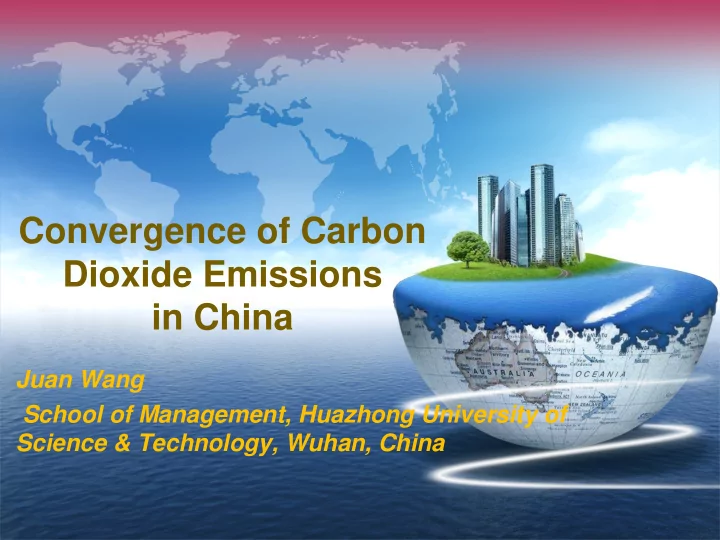

Convergence of Carbon Dioxide Emissions in China Juan Wang School of Management, Huazhong University of Science & Technology, Wuhan, China
Organization Introduction Related Literature Data and empirical methodology Empirical results Conclusions
Introduction Chinese government attach great attention on CO 2 emissions The distribution of CO 2 emissions varying widely across provinces in China CO 2 emissions should converge at a specified target It is absolutely necessary to understand the CO 2 emissions of each sector trends across the Chinese
Related Literature Ⅰ Inverted-U relationship between CO 2 emissions and income Dijkgraaf & Vollebergh, 2005; Jalil & Mahmud, 2009 Cannot be explained whether CO 2 emissions cross- county converge to steady state Studies on the convergence of CO 2 emissions across countries/regions Strazicich & List, 2003; Romero-Avila, 2008; Westerlund & Basher, 2008; Lee & Chang, 2008 Nguyen-Van, 2005; Ezcurra, 2007; Jobert et al., 2010
Related Literature Ⅱ Studies on the divergence of CO 2 emissions across countries/regions Aldy, 2006; Bulte et al., 2007; Barassi et al., 2008; Nourry, 2009; Criado & Greth2011 It is very important in the CO 2 emissions convergence issue to choose suitable estimation methods, building on considering character of sample fully, and re-examine the robust of tests
Data Panel data of 28 provinces during 1996-2009 Total population at the end of year in 28 provinces during 1996-2009 is taken from China Statistical Yearbook Energy consumption of every sector is taken from China Energy Statistical Yearbook
CO 2 Emissions Data Calculated from energy consumption, according to IPCC guidelines for national greenhouse gas inventories, combining with the statistical characteristics of energy balance sheet of annual China Energy Statistical Yearbook 15 ∑ = × × C ( E B F ) / peo i t , i t j , , j j i t , = j 1 is the energy consumption E i t j , , B is the coefficient of energy type being converted into j standard coal is the carbon emissions factor of energy type F j
Sector Classification Abbr. Sector 1.Farming, Forestry, Animal Husbandry, Fishery & Water FAM Conservancy 2.Industry IND 3. Construction CON 4. Transportation, Storage, Postal & Telecommunications Services TRA 5. Wholesale, Retail Trade and Catering Service WSA 6. Residential Consumption RES
2 1 0 1996 1997 1998 1999 2000 2001 2002 2003 2004 2005 2006 2007 2008 2009 -1 -2 Beijin Tianjin Hebei Shanxi Neimenggu Liaoning Jilin Heilongjiang Shanghai Jiangsu Zhejiang Anhui Fujian Jiangxi Shandong Henan Hubei Hunan Guangdong Guangxi Hainan Sicuang Guizhou Yunnan Shanxi Gansu Qinghai Xinjiang Fig.2 Cross-province carbon emissions in IND sector 1996-2009
Empirical Methodology Cross-province difference ( σ -convergence) ( ) 1 1 ∑ ∑ 2 n n − = ln c log c ,ln c ln c = = i i i 1 i 1 n n 2 c 1 1 ∑ ∑ n − = n i 1 , c c = = i i 1 i 1 n n c Testing for β -convergence = α + β + ε lngc lnc − i t , i t , 1 i t ,
Empirical results: σ -convergence Table 3 Standard deviation of CO 2 emissions per sector in 28 provinces during 1996-2009 FAM IND CON TRA WSA RES Standard deviation in 1996 0.82 0.61 1.04 0.68 1.01 0.84 Part A: Standard deviation in 2009 logc 0.63 0.44 0.85 0.59 0.98 0.55 Percentage change between 1996 and 2009 -0.24 -0.28 -0.19 -0.14 -0.03 -0.34 Part B: Percentage change between 1996 and 2009 c -0.14 -0.30 -0.02 -0.13 -0.40 -0.18
Empirical results: β -convergence Table 4 Unconditional β -convergence for CO 2 emissions per sector in 28 provinces 1996-2009 FAM IND CON TRA WSA RES Part A: OLS regression -0.0866 *** a -0.0373 ** -0.0738 *** -0.0702 *** -0.0431 ** -0.0959 *** β (0.000) b (0.0148) (0.000) (0.000) (0.0111) (0.000) Part B: FGLS regression -0.0904 *** -0.0591 *** -0.0430 *** -0.0558 *** -0.0473 *** -0.0972 *** β (0.000) (0.000) (0.000) (0.000) (0.006) (0.000)
Conclusion Per capita CO 2 emissions in all sectors do have σ - convergence in 28 provinces during 1996-2009 Per capita CO 2 emissions in all the sectors have an absolute β -convergence across provinces in China from 1996 to 2009 Narrow the gap of per capita CO 2 emissions among provinces though differentiated environmental protection
Recommend
More recommend